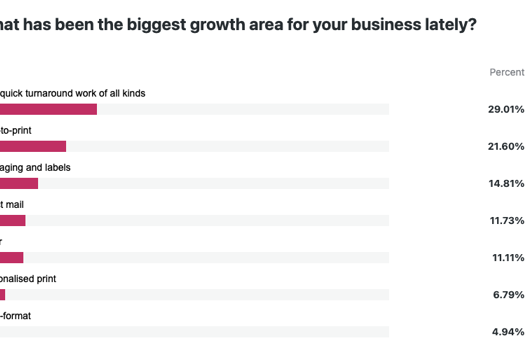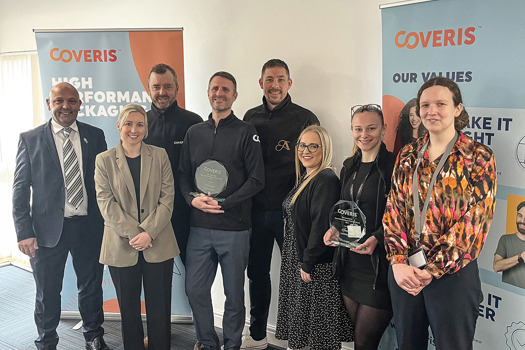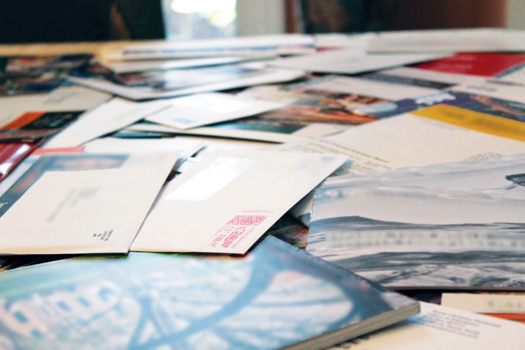There are many things that print can do that other media struggle with. Tactile techniques, those that impact the way a product feels, such as stock and coatings, are the most obvious advantages, but there are other effects that appeal to the eye and can’t be reproduced on screen. These include embossing, debossing and thermography, the shine and sparkle of metallic techniques and the range of finishes that coatings and varnishes can deliver.
At the heart of any attempt to produce value-added print is a conundrum: will a process add more value than it costs to use? Traditional techniques rely on additional processes, adding time, cost and complexity. So for the canny creative and their clued-up printer the Holy Grail has got to be a process that adds value with the minimum of additional cost.Nowadays, this means techniques that are compatible with digital printing or, for litho work, that can be produced on-press during the run. Digital’s strength in short-run and, even more so, personalised work, means any process must be reliable with zero makeready time or waste.
That’s a relief
For high-volume, one-pass production, Manroland has developed a technique to produce a relief image in the same pass as printing, which it calls Inline Impress. It requires a double UV coater configuration; the first coater applies a UV varnish and the second cylinder has a relief plate which embosses the varnish, without affecting the underlying substrate.
Similar cast-coating techniques use film rather than a plate to produce the pattern, including pseudo holographic and optical effects.
If it’s digital print you want to raise above average, the routes to go down depend on what kit you’ve already got.
Kodak NexPress users can add Dimensional Printing. A handful of UK firms have done so and are delighted with the results including Synergie in the Midlands and X1 in Slough.
Synergie managing director Terry Hannam describes it as "the easiest sell of any product I’ve ever known". He adds that a postcard sent cold to one prospect won the firm five orders, and even new litho business. Not bad for a process that doesn’t slow the press down and is easy to use for both designer and printer – you treat it as a fifth colour. Although only suitable for a small percentage of jobs it invariably results in repeat business.
The cost of using Dimensional Printing depends on the area and the depth of the coating applied, ranging from "insignificant" to "expensive if overused", although typically adds about one-third to the client’s price.
"You can combine personalisation with dimensionality, and at that point the price almost becomes irrelevant for the customer," says X1 sales and finance director Tim Lance.
Synergie has also opted for the inkjet option adding depth with Roland DG’s VersaUV LEC-330. This 762mm-wide roll-fed UV-cured inkjet printer and cutter lays down clear and white ink as well as CMYK, offering a range of finishes from matte through to gloss and texture including Braille by building up layers of coating.
Israeli firm Scodix, has developed what it calls a digital embossing press, the Scodix 1200. It’s a digital UV coater that can lay down a thick layer of varnish to produce relief. RCS in Retford has become the first firm in the UK to take one.
One way of adding depth without producing any relief is 3D imaging, which also ties in with the vogue for 3D movies and TV. The most elegant way to– because it doesn’t need the viewer to wear special glasses – is lenticular. This works by using a plastic sheet ridged with lenses that the image is either printed directly to the back of or laminated onto.
One of the handful of firms producing lenticular work is Print-Leeds, which uses a Heidelberg CD 74 running UV inks to produce litho work and has recently invested in a Screen Truepress Jet1600UV-F for large-format digital work. Historically lenticular has been an expensive and difficult process says managing director Rod Fisher costing a minimum of £5,000 due to the high minimum order quantities for the materials and expensive pre-press costs.
"It used to cost £1,200 to get a set of lenticular separations," he says. "No wonder that killed the market."
The firm has invested £20,000 developing its own software and has become a specialist that offers training in the process. He reckons that now it would be possible for a one-off job to be produced for as little as £750.
Depth is only one string to lenticular’s bow, it can also add movement.
The Dutch post office recently released a 350,000-run edition of lenticular stamps that showed what it billed as the shortest film in the world, a 30-frame 1s short directed by Anton Corbijn, while in the new year lenticular is go with a set of UK stamps commemorating Thunderbirds.
It’s also possible to create movement without lenses. The October issue of Wallpaper* incorporated moving and colour shifting images produced by agency Dentsu London using a process called Ombro Cinema. This technique uses a ruled plastic sheet moved across the page to alternatively mask and reveal strips of the image below. A similar technique called Scanimation is used in a series of children’s books, where the screen is moved by turning the page.
Future foil
Foiling is another way of adding polish, but it’s been restricted by the speed of production and the set-up cost. For jobs where added sparkle would be nice, but the absolute and undeniable quality of hot foiling isn’t required, new options are emerging.
One example is the cover of this supplement, produced by Manroland using its Prindor inline foiling system. This and similar systems such as Heidelberg’s Foilstar and the Foiltone system use two units of an offset press to apply cold foil.
The first unit applies glue using a standard plate and the foil is transferred in the second unit. The foil can be overprinted with colours and varnishes. Applying process and special colours enables a wide range of effects and metallic colours to be produced without having to hold inventory of coloured foils.
Other options include metallic ink, or to combine a mirrored board with white ink where the white is applied in the areas that you don’t want to appear metallic.
This approach opens up metallic effects to digital print, for short runs and personalisation.
Being able to easily produce metallic work is only half the battle, the creative community needs tools that make it easy to design for, including visualisation and proofing. Color-Logic’s Process Metallic Color System delivers that regardless of how you add shine on press with plug-ins for Adobe Creative Suite and Quarkxpress.
Printers using the system provide samples/marketing materials produced using their machines, materials and working conditions. The start up cost for the software is a under a grand. The benefit of all these approaches over conventional foiling is that the results are produced during the print run, keeping down cost and time. Machines such as Epson’s Stylus Pro WT7900 and Roland DG’s Versa UV’s and metallic capable eco-solvent inkjet machines make it possible to proof too.
MULTIMEDIA: 2D BARCODES/QR CODES
Competing with other media is all well and good, but essential to print’s success is the ability to tie in with digital media.
This is where 2D barcodes come in. These squares that resemble a chessboard gone random (see the illustration on p31) can be deciphered via software installed on a mobile phone. Examples of what can be encoded include URLs, email addresses, phone numbers and even sounds.
If you buy fancy enough software, it’s possible to create codes that take the recipient to a PURL (personalised URL) too, providing a totally bespoke multichannel experience. The most popular version is the QR code, devised by Japanese firm Denso-Wave, but there are others including Microsoft’s Tag and UpCode.
Code readers are increasingly being pre-installed, while for smart phones such as Apple’s iPhone that have an app store there are readers that can be downloaded, most of which are free. These codes are a handier way of getting to a website than typing in a URL and can be customised for different marketing campaigns, media, locations or even individual recipients. Using an analytics dashboard it’s possible to track where users have clicked in from. For the first time it can be shown that someone has been influenced directly by print. Imagine knowing which particular poster piqued a passer-by’s interest or which edition of a magazine someone responded to.
Simple online code creators are free, but if you want the capacity to create a lot of custom codes – and if you’re printing digitally and want to use analytics to the greatest effect you will – then an industrial strength solution will cost.
Including the codes in a print job costs nothing – they can be supplied in PDF, EPS, PNG or JPG formats, so can be placed using DTP tools and can be printed by any process. You need to ensure they are big enough to be read and there is enough safe area around them to allow the software to identify them.
There’s no shortage of techniques brought bang up to date for the digital age and new tools that breathe life into the oldest medium around that prove print is still powerful, and can hold its own.









